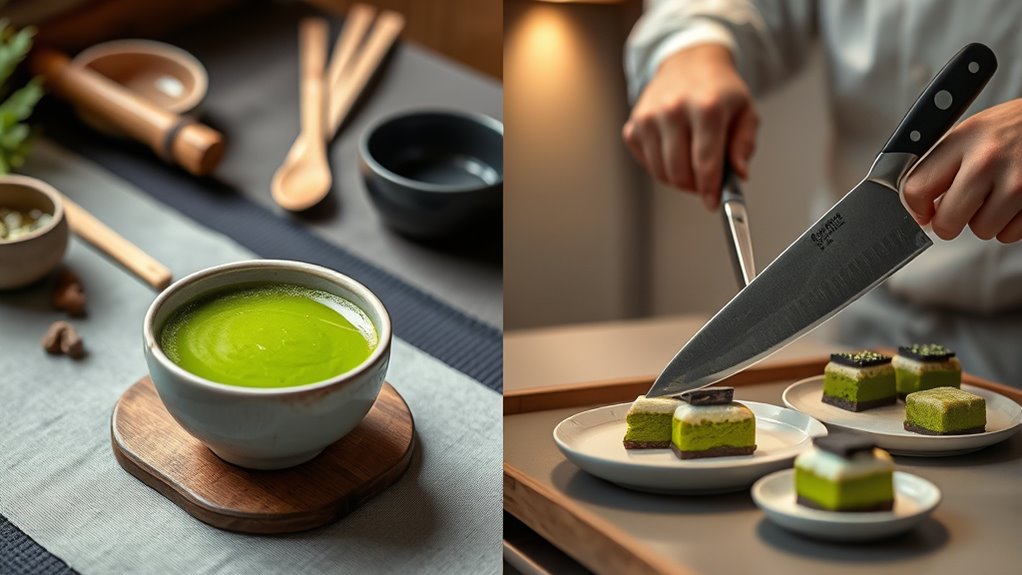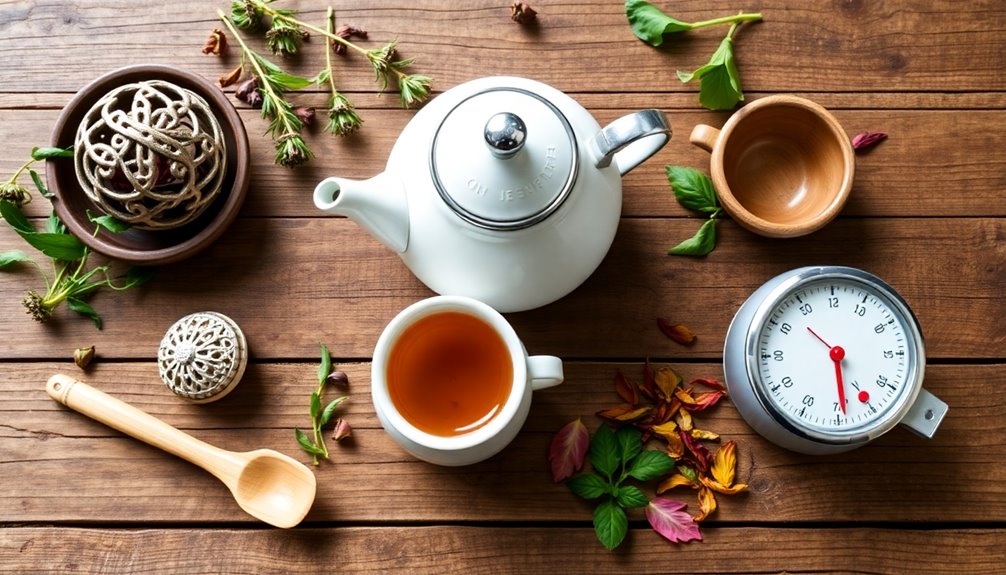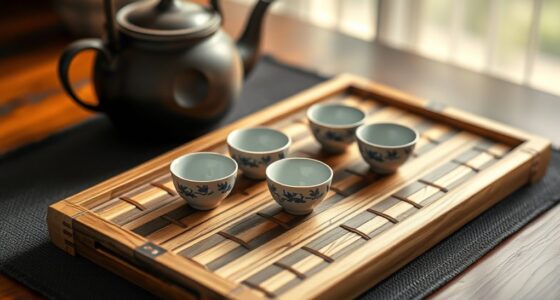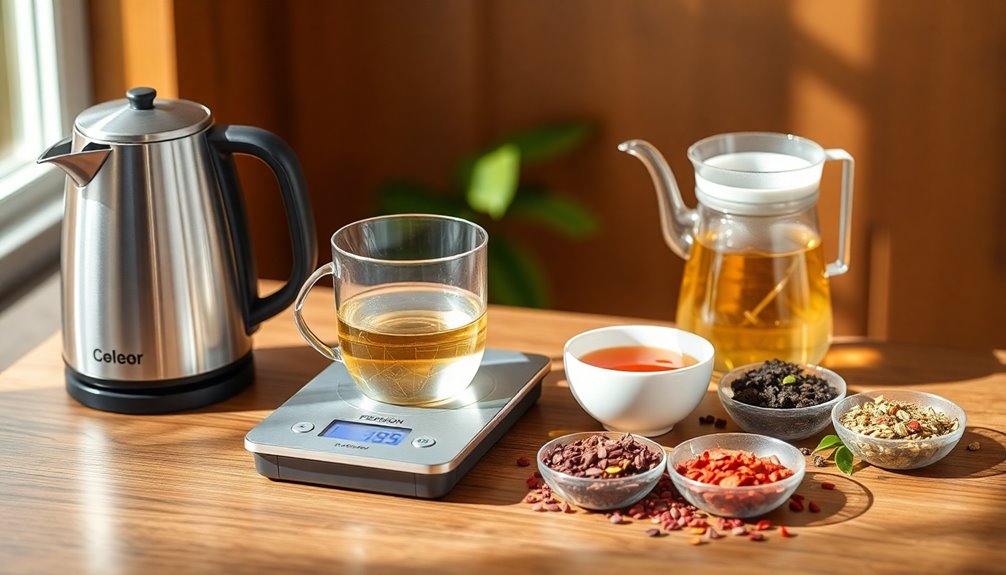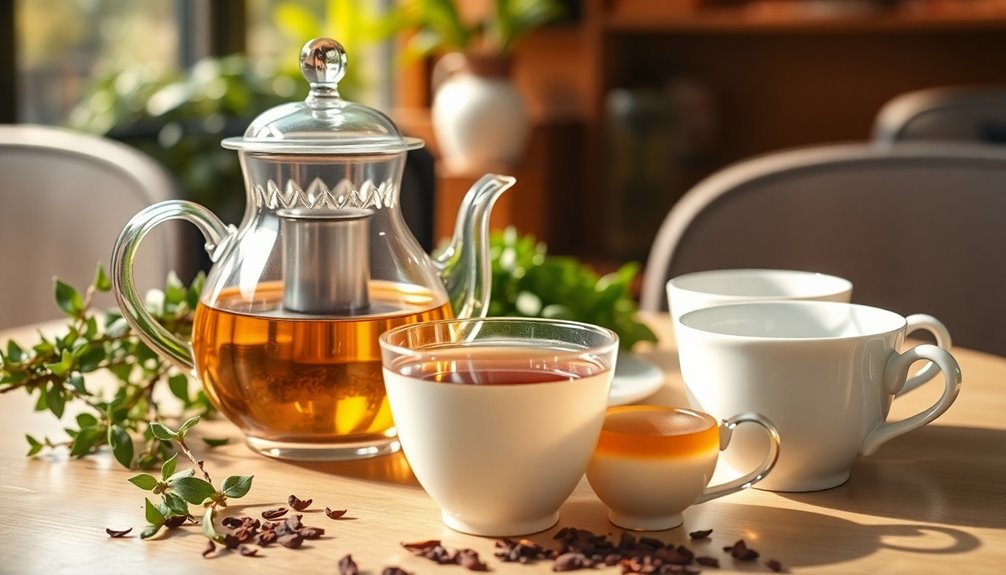Ceremonial matcha is crafted from high-quality, shade-grown leaves and is prepared gently to highlight delicate, nuanced flavors, making it ideal for savoring pure, smooth tea. In contrast, culinary matcha comes from slightly lower-grade leaves, has a bolder, earthier taste, and is better suited for smoothies, desserts, and cooking where the flavor needs to stand out. Understanding these differences can enhance your enjoyment and use; exploring further reveals how each type suits different moments.
Key Takeaways
- Ceremonial matcha is high-quality, finely ground, and prepared gently to highlight delicate, complex flavors; culinary matcha is more robust and less refined.
- Ceremonial matcha is meant for sipping and appreciating its subtle nuances, while culinary matcha is used in recipes for its bold flavor.
- The preparation of ceremonial matcha involves whisking to create a smooth, frothy top; culinary matcha requires no frothing.
- Ceremonial matcha uses shade-grown leaves for a refined taste; culinary matcha is made from slightly lower-grade leaves for stronger, earthy flavors.
- The flavor profile of ceremonial matcha is smooth and subtly grassy; culinary matcha tends to be more intense, bitter, and earthy.

Have you ever wondered what sets ceremonial and culinary matcha apart? The key differences lie in their tea preparation, flavor profiles, and intended use. When you’re choosing between the two, understanding these aspects can help you make the best decision for your needs. Ceremonial matcha is crafted to be enjoyed on its own, highlighting its delicate, nuanced flavors. It requires a specific tea preparation process that emphasizes gentle whisking and a smooth, frothy top. This preparation involves using high-quality, finely ground powder, typically from shade-grown tea leaves. The goal is to extract the purest, most refined flavors without any bitterness or harshness. You’ll notice that ceremonial matcha has a vibrant green color and offers a smooth, slightly grassy taste with subtle sweetness. Its flavor profile is complex and delicate, making it perfect for savoring slowly during traditional tea ceremonies or moments of quiet reflection.
On the other hand, culinary matcha is designed with versatility in mind. It’s usually made from slightly lower-grade tea leaves, which makes it more robust and forgiving in various recipes. When you prepare culinary matcha, the tea preparation process is less delicate—it’s often mixed directly into hot liquids or baked goods without the need for frothing. Its flavor profile tends to be more intense, sometimes with a slightly bitter or earthier note, which complements other ingredients well. Culinary matcha’s strength allows it to stand out when added to smoothies, desserts, or savory dishes, providing a deep, rich flavor that enhances rather than overwhelms. Because of its more assertive taste, it’s less about enjoying the subtle nuances and more about balancing flavor in recipes.
Ultimately, your choice depends on how you want to experience matcha. If you’re seeking a refined, smooth, and nuanced tea experience, ceremonial matcha is the way to go. It’s all about appreciating the tea’s natural flavor through careful preparation. If you’re looking to incorporate matcha into your cooking or want a bolder flavor that can stand up to other ingredients, culinary matcha is perfect. Knowing the differences in tea preparation and flavor profiles helps you select the right matcha for your lifestyle and taste preferences. Whether you prefer to sip it slowly or blend it into recipes, understanding these distinctions guarantees you enjoy matcha exactly how you want.
Frequently Asked Questions
Can Culinary Matcha Be Used in Traditional Tea Ceremonies?
You might wonder if culinary matcha can replace ceremonial matcha in traditional rituals. While culinary matcha offers robust flavor profiles ideal for recipes, it doesn’t quite match the delicate, nuanced taste used in ceremonial rituals. Using culinary matcha in these settings can compromise the authentic experience, as the flavor profiles differ. For an authentic experience, it’s best to stick with ceremonial grade matcha during traditional tea ceremonies.
How Does Processing Differ Between Ceremonial and Culinary Matcha?
Ever wondered how processing differs between ceremonial and culinary matcha? You’ll find that ceremonial matcha is made with the finest leaves, harvested carefully using selective harvesting methods. The drying techniques preserve vibrant color and delicate flavors, ensuring a smooth, refined taste. In contrast, culinary matcha often uses broader harvesting methods and quicker drying, resulting in a more robust flavor suited for cooking. This difference highlights the unique qualities each type offers.
Are There Health Benefits Unique to Ceremonial Matcha?
You might notice that ceremonial matcha offers unique health benefits, thanks to its higher antioxidant levels and pure, high-quality leaves. It generally contains a moderate caffeine content, giving you a gentle energy boost without jitters. Drinking ceremonial matcha regularly can support your immune system, improve focus, and provide calming effects due to its rich concentration of antioxidants, making it a healthy choice for enhancing overall well-being.
Is Culinary Matcha Suitable for Latte Art or Specialty Drinks?
Culinary matcha is quite suitable for latte art and specialty drinks. Its vibrant green color creates beautiful matcha foam, making your latte art stand out. While it may not have the same delicate flavor as ceremonial matcha, culinary matcha still offers good latte art compatibility. You can enjoy visually appealing drinks with a rich, earthy taste, perfect for customizing your beverages and impressing guests with your latte art skills.
How Should I Store Different Types of Matcha for Best Quality?
Imagine your matcha as a treasure that needs safeguarding! To keep it fresh and vibrant, store different types in airtight containers away from light, heat, and moisture. For the longest shelf life, refrigerate or freeze ceremonial matcha, while culinary matcha stays best in a cool, dark pantry. Follow these storage tips, and your matcha will stay flavorful, aromatic, and ready to elevate every sip!
Conclusion
Whether you choose ceremonial or culinary matcha, you’re embracing tradition and versatility. One offers mindfulness and elegance, while the other provides convenience and creativity. Both invite you to enjoy health benefits, unique flavors, and rich cultural history. With each sip or spoonful, you connect with a centuries-old ritual, a modern culinary adventure, and a personal experience. Ultimately, your choice reflects your purpose, your taste, and your journey into the vibrant world of matcha.

